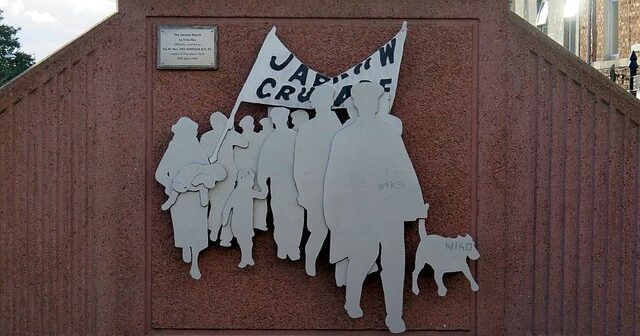

Joy Macready and Dave Stockton look at the historical lessons and what can be learnt today
In the 1930s Britain, like many other countries, was suffering from the effects of the Great Depression, and areas of heavy industry like Jarrow were hardest hit.
At that time, unemployment benefit lasted only for 26 weeks, and after 1931 any further relief was subject to a harsh Means Test, where the entire family’s income and resources were assessed. Relief was denied until all savings and resources had been used up.
Many families were evicted from their homes, while able-bodied men on Poor Relief were ordered to do hard labour without pay, like crushing stones for road building.
While 200 men marched from Jarrow, no women were invited to take part, with the exception of Jarrow’s Labour MP Ellen Wilkinson, who accompanied the march for parts of its route.
The men were demanding that a steel works be built to bring back jobs to their town, as the big shipyard in Jarrow had been closed down in the previous year. The yard had been Jarrow’s major employer, and its closure compounded the existing problems of poverty, overcrowding, poor housing and high mortality rates.
The marchers themselves were warmly received in towns and cities along the route and helped by local trade unions and local Labour Parties, despite the fact that the Trade Union Congress (TUC) and the national Labour Party instructed their branches not to support it. Indeed, the Labour movement’s official leaders didn’t launch a single campaign against unemployment throughout the 1930s.
Perhaps for this reason, the marchers’ demonstration at Hyde Park Corner on 1 November 1936 was sparsely attended compared to a nearby Communist Party rally, which decided to join them to swell their numbers. The marchers had collected 12,000 signatures for the Jarrow petition for work, which Ellen Wilkinson presented to the House of Commons on 4 November.
However she dissuaded the marchers from political agitation in the capital, including from staging a sit-in. Instead she sent them on sightseeing tours. Nevertheless Prime Minister Stanley Baldwin refused to meet the marchers and would do nothing for them. All they were given was £1 each to get the train back from London. Jarrow’s shipyards remained closed till the outbreak of war, and the town was the scene of severe rioting in 1939.
An alternative – militant political struggle
The Jarrow Crusade generally gets a good press precisely because it proclaimed itself apolitical and sought support from Tories and Liberals. No Communists were allowed to participate. Moreover it concentrated narrowly on Jarrow. Yet compared with the Hunger Marches of the National Unemployed Workers’ Movement (NUWM), it was small scale and decidedly un-militant affair. Even the name on its banners – crusade rather than march – was meant to distinguish it from the Communists.
The NUWM, led by Communist Party members Wal Hannington and Harry McShane, had about 50,000 members, organised in local branches across the country. It organised ‘hunger marches’ against mass unemployment in 1922, 1929, 1930, and 1932.
It biggest effort was in 1932 – the trough of the great depression with unemployment at 2,750,000. That year the NUWM mobilised in many cities against the Means Test, against evictions and reductions in Poor Relief. Violent clashes occurred between the unemployed and the police. In October, 18 contingents from as far away as Scotland and Northern Ireland converged on London. They carried with them a petition demanding an end to the Means Test signed by more than a million people. In Hyde Park, 100,000 people mobilised to welcome them.
The government was frightened and vicious. It mobilised 70,000 police, more than at any time since the Chartist demonstrations in 1848. It deployed agents provocateurs to foment trouble. Constables on horses charged the crowd and seized the petition, refusing to allow it to be presented to Parliament. A battle ensued at Hyde Park Corner, and rioting in the capital continued for four days, in which 70 people were seriously injured. Further NUWM marches took place in 1934 and 1936 all much larger than the Jarrow Crusade.